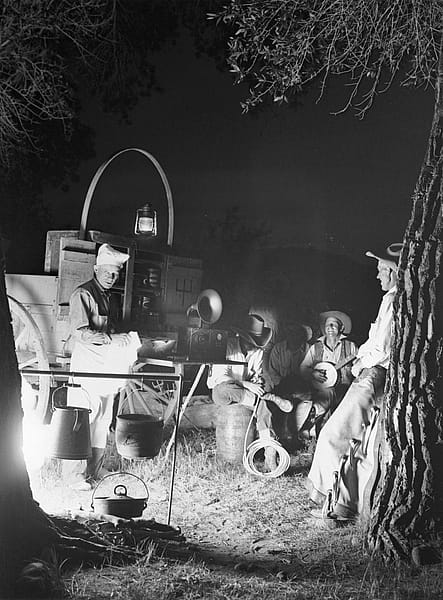
Biscuits anyone? It’s chow time on the trail…

Buffalo Bill Center of the West, Cody, Wyoming, USA. Gift of Mr. and Mrs. W.D. Weiss. 27.97.12
After a dusty day on the cattle drive, cowhands were plum tickled when they caught a whiff of the trail trifecta of biscuits, bacon, and beans. There was one small snag, though: No one ate until Cookie called.

On the old time cattle drives, the cook, “Cookie,” was often an aging cowboy hired for his ability to drive a wagon more than his cooking skills. He was in charge of the chuckwagon and everything related to it. He was typically paid more than the other hands because the success of the camp and the drive depended greatly on him. A cowhand earned about a dollar a day, but Cookie made twice that.

As he readied the chuckwagon for the long trip ahead, Cookie loaded it with provisions like coffee, sugar, and the trail triune’s beans, bacon, and flour for those biscuits. He loaded more supplies along the way whenever possible, but Cookie’s grub was also greatly influenced by what was available.
Indigenous plants and animals supplied much of the food—think buffalo and squirrel! By necessity, Cookie prepared food over an open fire using very simple methods with tools like Dutch ovens, frying pans, boiling pots, and roasting spits to feed the cattle hands.
For the most part, cowboy chow was digestible if not palatable. Still, a common cowboy cliché was uppermost in the minds and bellies of trail hands, “Always take a good look at what you’re about to eat. It’s not so important to know what it is, but it’s sure crucial to know what it was.”

Make the Buffalo Bill Center of the West part of your Yellowstone vacation itinerary!
Written By
Marguerite House
Marguerite House served as the Center of the West’s Acting Director of Public Relations until her retirement at the end of 2018, and as editor of its member magazine, Points West, through May 2019. Following a seven-year stint as Business Manager for the Cody Country Chamber of Commerce, Marguerite moved “across the street” to the Center in 1999. She then held five different positions in three of the Center’s four divisions, landing in PR in 2005. “I think that [gave] me all kinds of perspectives for our readers,” she says. She enjoys writing (especially a weekly column for the local newspaper called “On the House”), cooking, and spending time with her six grandkids.










